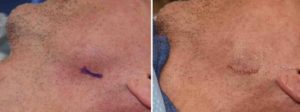Jaw angle implants are typically inserted through an intraoral route. This allows a subperiosteal pocket to be developed under the masseter muscle in a scarless fashion. But it is a procedure that is prone to implant asymmetry for an often not appreciated reason. The wording end of the implant is the furthest away from the incision and its position on the bone can not be fully seen. This makes getting the implant in the ideal position along the jaw angle to always completely predictable.

But there is a role for an external skin incision in jaw angle implants in very select patients. For the male patient who wants to avoid re-opening their intraoral incision and all the recovery and risks that may ensure, the external approach offers that advantage. It works best in silicone jaw angle implants which can more easily be manipulated /repositioning through small skin incisions.
Surgeons may be hesitant to consider this approach because of the marginal mandibular branch of the facial nerve. But this nerve branch lies below the actual bony edge even with the patient’s head turned to the side. Just like the well known Risdon neck incision is made below the path of the nerve, the angle skin incision is made above the path of the nerve.
Dr. Barry Eppley
Indianapolis, Indiana


